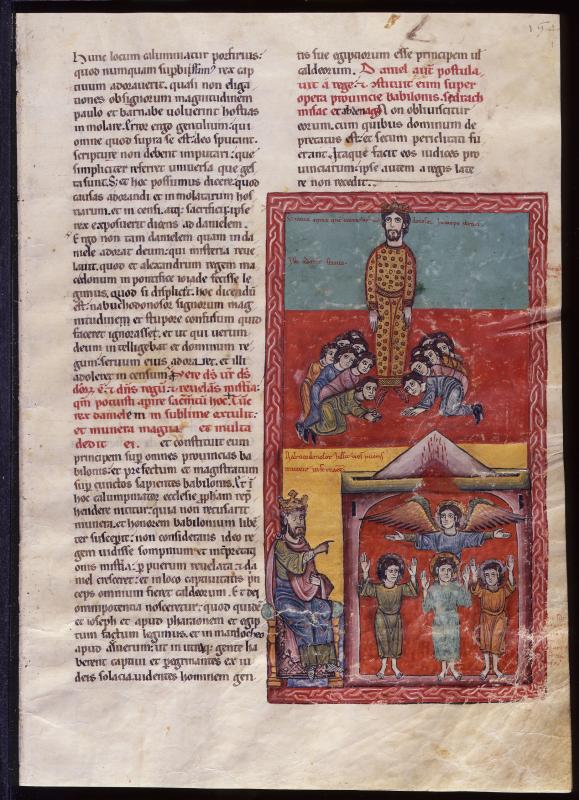
Commentary on the Apocalypse and commentary on the Book of Daniel
Purchased by J. Pierpont Morgan (1837-1913) in 1910
Nebuchadnezzar: Worship of Image (Daniel 3:7) -- Crowned image flanked by prostrate men; background inscribed STATUA AUREA QUEM NABUCODONOSOR IN CAMPO URAM. ISTA ADORANT STATUA.
Three Hebrews: in Fiery Furnace (Daniel 3:23-25) -- Nebuchadnezzar crowned, seated on cushioned bench, pointing to Three Hebrews nimbed, one with pearled nimbus, before angel, pearled nimbus, in furnace with fire ascending from opening; background inscribed NABUCODONOSOR IUSSIT TRES PUERIS MITTERE IN FORNACEM.
Text from Jerome, In Danielem II.
King Nebuchadnezzar made a statue of gold, sixty cubits high and six cubits wide, and set it up in the plain of Dura in the province of Babylon. Then King Nebuchadnezzar dedicated the statue, and a herald proclaimed that when the music was heard, all must fall down and adore the gold statue; those who did not would be cast into a burning furnace. But Shadrach, Meshach, and Abednego [the names given to Hananiah, Mishael, and Azariah by the king's master of the eunuchs] could not obey, saying that their God could rescue them from the oven of burning fire and free them from his hands. And the furnace was heated so excessively that those who cast them in were themselves killed by the flames. But the three men walked in the flames, praising God and blessing the Lord. And the angel of the Lord descended into the furnace; and he cast the flame of the fire out of the furnace. And Hananiah, Mishael, and Azariah were freed. Nebuchadnezzar was amazed, saying, "Blessed is their God, who sent his angel and rescued his servants who believed in him." And they altered the king's verdict, so that they would not serve or adore any god except their God. (Dan. 3)
At the top Babylonians adore the statue that resembles the king below, who points to the angel driving out the fire. The three Hebrews, hands raised, sing their famous canticle of thanksgiving (Benedicite).
